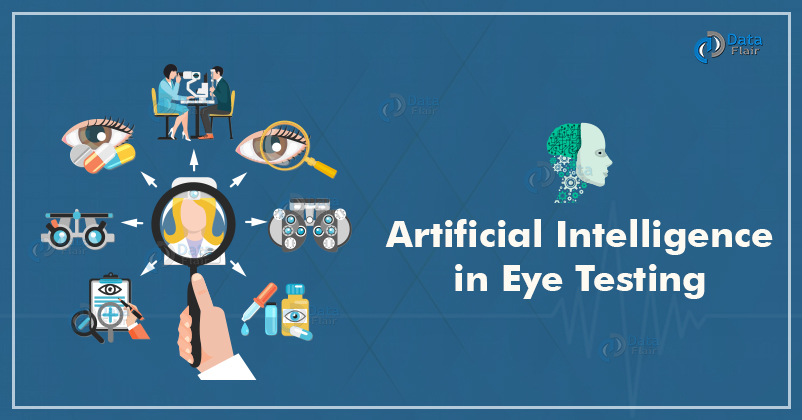How Artificial Intelligence can aid in Eye Testing – AI in Ophthalmology
Free Machine Learning courses with 130+ real-time projects Start Now!!
AI frameworks are gradually figuring out how to analyze ailment just as any human specialist. They could do this before long be working in a medical clinic close to you. From diagnostics to research and development for new drugs, AI today has become an important augmentation of the clinical field.
Another expansion to its not insignificant rundown of employments is a high tech screening device created by Google. This is developed by a global group of scientists for recognizing diabetic retinopathy a diabetic confusion in the eye.
In this AI tutorial, we will see how Artificial Intelligence can aid in Eye Testing?
How Artificial Intelligence can aid in Eye Testing?
Let’s see how AI can effectively help in eye testing?
Diabetic retinopathy influences over 30% of patients with diabetes. It harms the small veins in the retina and can prompt visual impairment whenever left untreated.
Shockingly, while early finding and treatment can keep practically all vision misfortune from diabetic retinopathy, around half of individuals don’t realize they have it until it’s arrived at a propelled arrangement.
That is the reason customary eye screening is basic. Early discovery of diabetic retinopathy could be significantly improved if screening should be possible in more GP and endocrinology facilities, says Professor Mingguang He, Principal Investigator in Ophthalmic Epidemiology at CERA.
“In any case, the test is that numerous GPs don’t have the specialized certainty to inspect the retina – the rear of the eye,” says Professor Mingguang He says. AI could help change this. He has built up a creative AI screening instrument.
This was intended to give GPs and endocrinologists a straightforward approach to identify indications of eye illness.
Presently, he’s working with investigating individual Dr. Jane Scheetz to test the clinical mix of the AI screening apparatus in GP, endocrinology, and Indigenous wellbeing settings. “The AI framework has been prepared to utilize 70,000 pictures of the retina,” says Dr. Scheetz.
He adds that presently, it is exceptionally precise in deciding if somebody has changes brought about by diabetes – more exact than a human.
“The essential point is to screen for diabetic retinopathy, yet the calculation can likewise search for glaucoma, age-related macular degeneration, and waterfall – so it can screen for the four most basic blinding eye infections without a moment’s delay.”
The screening takes only seconds. In the wake of snapping a picture of the rear of a patient’s eye, the AI framework checks for indications of infection, and prints out a report recognizing if the patient ought to have alluded to a pro for additional appraisal and treatment.
“In the course of the most recent year and a half we’ve been trialing the framework in genuine settings – like the Endocrinology Clinic at St Vincent’s Hospital, Box Hill Hospital, Derbarl Yerrigan Health Services in Perth and now in an Aboriginal people group in South Australia,” Dr. Scheetz says.
Making eye screening increasingly available
This work has roused Professor He to structure a completely computerized, administrator free form of the screening device as the energizing next stage.
“Later on, screening of eye maladies could be as simple as taking representation in a photograph corner,” he says.
The expectation is that this innovation will build availability to diabetic retinopathy screening for all Australians. Specifically, it could have an immense effect in territorial and remote territories where eye wellbeing administrations are inadequate.
“Man-made reasoning can possibly close the hole in eye care administrations. It can significantly increment early analysis of the four most basic blinding eye illnesses. It will also decrease the weight of vision misfortune in the Australian people group that needs it the most.”
Take an example of DeepMind AI by Google which is highly active in the healthcare space. About 15,000 OCT checks from around 7,500 patients helped in preparing it.
These people had been treated at destinations worked by Moorfields, which is the biggest eye medical clinic in Europe and North America. The framework was taken care of by their outputs nearby findings by human specialists.
From this, it figured out how to initially distinguish the diverse anatomical components of the eye (a procedure known as division). This was followed by suggesting clinical activity dependent on the different indications of illnesses that the sweeps appear.
Summary
In conclusion, AI is going to provide a helping hand to humans in many of their extremely critical works. The time is right for AI to emerge as a building block upon which further technological development is to be made.
The aid of AI in eye testing is just one of these initial foundation stones. After all, there’s a long way to go. Finally we got answer to the question “How Artificial Intelligence can aid in Eye Testing?”
If you are Happy with DataFlair, do not forget to make us happy with your positive feedback on Google


